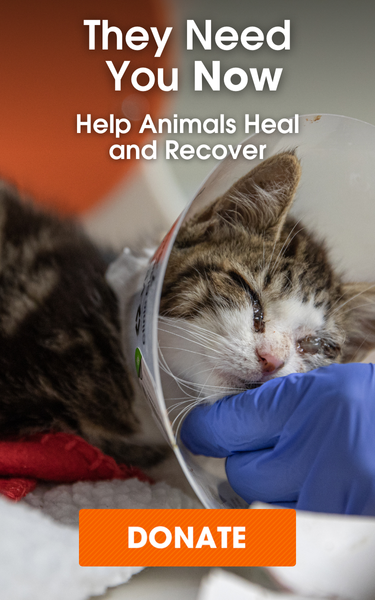
Miracle Cat Survives Terrifying Fall, Makes Incredible Recovery

It was a chilly afternoon in late October 2023 when a group of people witnessed a cat fall from the window of a sixth-floor apartment in Brooklyn. The cat hit the ground hard and scurried into a nearby garage.
“We got a call right away,” says Lindsay Branch, rescue manager for Flatbush Cats, a non-profit organization in Brooklyn specializing in cat rescue and trap–neuter–return (TNR).
Lizzy Carrena, Flatbush Cats’ board director and a volunteer, went to the garage, where she scooped the two-year-old gray cat into a carrier and rushed him to the nearby Veterinary Emergency Referral Group (VERG). She named him Beverly since he had fallen from a building on Beverley Drive. Although Beverly is a male, the name stuck.
“It was a fraught moment; Lizzy could barely touch him, he was in so much pain,” says Lindsay. “He also had difficulty breathing.”
Excessive Injuries
At VERG, a critical care specialist examined Beverly, logging a host of injuries: multiple pelvic fractures, a rib fracture, a broken shoulder blade, metatarsal fractures, a femur fracture, fluid in the chest cavity and abdomen, trapped air in the chest, bruised lungs, a fractured canine tooth, a torn lip and bitten tongue, and facial injuries. Veterinarians also suspected a traumatic brain injury based on a neurologic exam.
“The specialist called me to relay Beverly’s horrific injuries, all of which happened at once as a result of falling,” says Dr. Aubrey Crowley, Medical Supervisor at the ASPCA Animal Recovery Center (ARC), which handles daily care of animals involved in suspected cruelty cases. The case remains open.

“He had so much trauma and would require multiple surgeries and extensive physical rehabilitation. We considered, ‘Is this too much to put him through?’” Dr. Crowley says. “The six to eight weeks following would be challenging. But he seemed to be a young, healthy cat in good body condition before his devastating fall. Given all this, we decided to move forward.”
Beverly spent four days at VERG where he was placed in an oxygen cage. He received pain medicine as well as “down cat” care, where he was gently flipped every few hours to avoid developing pressure sores. Once stable and breathing regularly, he was transferred into our care on November 3.

Beverly underwent a femoral head ostectomy (FHO), a surgical procedure that removes the head and neck of the femur to relieve pain and restores mobility. His left hind limb metatarsal bones were also splinted to keep him stable.
High-Rise Syndrome
Beverly fell from an elevation that’s “one of the worst heights to fall from,” says Dr. Crowley, adding that Beverly was one of the worst cases the ARC has ever seen where the cat survived.
“At lower heights like two stories, falling cats have a righting reflex, where they position their limbs underneath their bodies in a flexed position,” she says. “At these heights, the damage is primarily to their legs. However, as cats approach terminal velocity and fall from greater heights, they orient themselves more horizontally, leading to chest and abdominal injuries, and broken bones, like we saw with Beverly.”

Veterinary professionals have a name for the malady: High-Rise Syndrome. Most victims fall accidentally from windows, terraces and fire escapes, and occur when cats focus intensely on something, such as a bird, which can distract them so they lose their balance.
“It’s so important to have proper screens if you have a cat,” says Dr. Crowley. “Unscreened windows pose a life-threatening risk.”
Next Step: Physical Therapy
Beverly soon began physical therapy to rebuild muscle.
“He was reluctant or unable to move his left hind leg,” says Erica Valenti, a Licensed Veterinary Technician (LVT) who administered physical therapy with Susan Lee, another LVT. “Three times a day we applied a passive range of motion to Beverly’s left hip, and flexed and extended it 15 to 20 times.”
Beverly remained on a pain medication called Zorbium, which is applied directly to the skin and lasts for four days.
“Zorbium is a newer medication that reduces stress on pets and caretakers when it comes to administration,” says Dr. Crowley. “We didn’t have to poke or pill Beverly which made the process of healing less stressful.”
While Erica and Susan oversaw physical therapy, integrated care assistants fed Beverly treats.
“He was initially afraid to get on the floor and had some appetite struggles, so we hand-fed him,” says Ayleen Cruz, Feline Behavior Specialist. “We tried to pair everything with treats until he got more confident. Eventually, he leaned in for petting on his cheeks.”

A Happy Ending
In January, Beverly had dental surgery to remove his broken tooth. He was then returned to Flatbush Cats and placed with a foster caregiver.
Beverly was adopted on January 19 after Flatbush Cats conducted a “meet and greet” over Zoom with his would-be adopter.
“Despite what he went through, he still has a loving personality,” says Lindsay. “We adore him and are grateful for the care you provided. The ASPCA was Beverly’s hero, for sure.”

